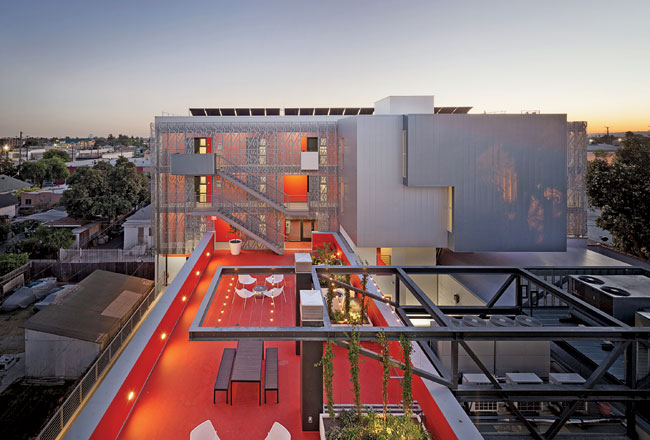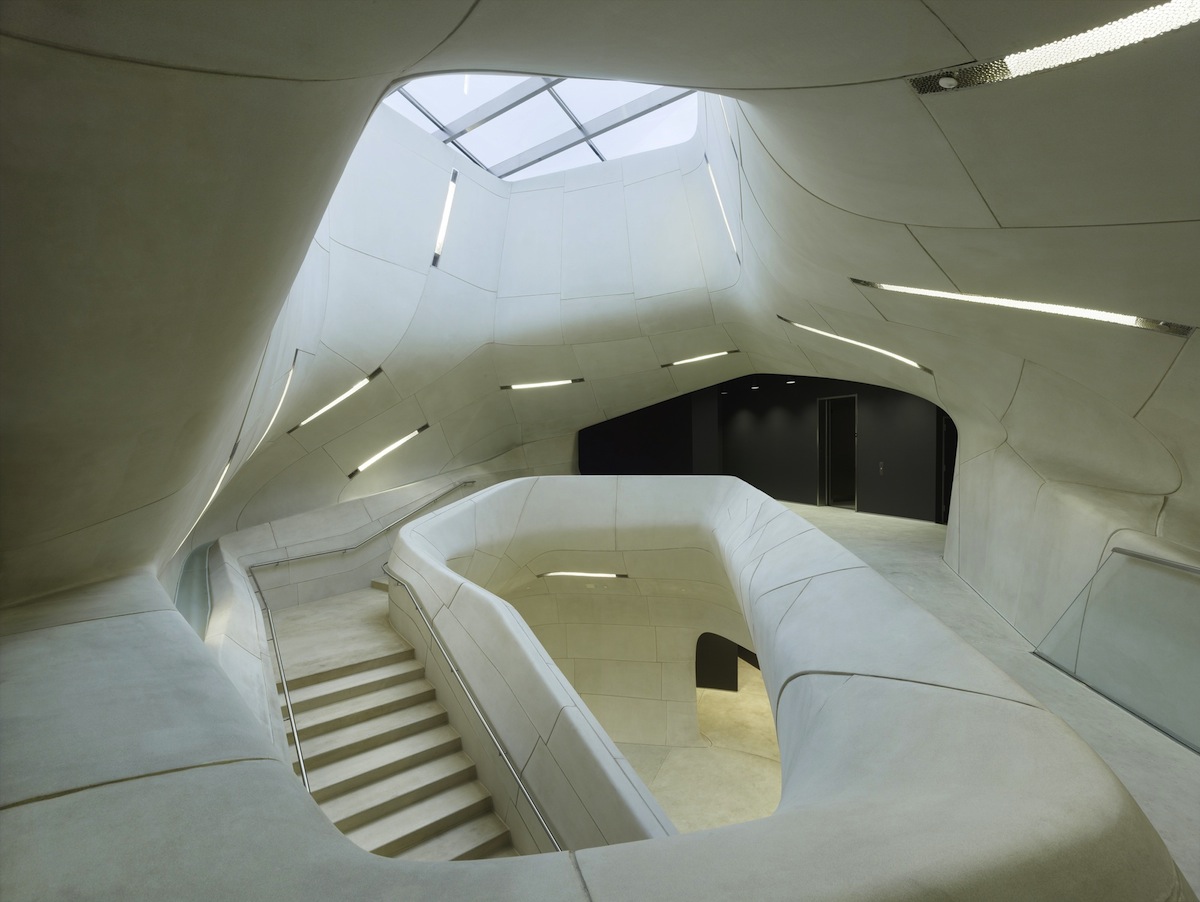The American Institute of Architects (AIA) has selected the 2015 recipients of the Institute Honor Awards, the profession’s highest recognition of works that exemplify excellence in architecture, interior architecture, and urban design. Selected from roughly 500 submissions, 23 recipients located throughout the world will be honored at the AIA 2015 National Convention and Design Exposition in Atlanta.
The 23 winners are broken out into three categories: Architecture, Interior Architecture, and Regional and Urban Design. Here's a recap of the winning projects (descriptions and images courtesy AIA). For more images, see the AIA's report on the winning projects.
Architecture Awards
The 2015 AIA Institute Honor Award for Architecture jury includes: Calvin Lewis, FAIA (Chair), Iowa State University; Ray Calabro, FAIA, Bohlin Cywinski Jackson; Nicole Gerou, AIAS Student Representative, Lawrence Technological University; Ana Guerra, Assoc. AIA, Jacobs; Sherri Gutierrez, AIA, Arquitectonica; Jill Lerner, FAIA, Kohn Pedersen Fox; James McDonald, AIA, A&E Architects; Waller McGuire, Executive Director, St. Louis Public Library and Angela O'Byrne, FAIA, Perez.
28th Street Apartments; Los Angeles
Koning Eizenberg Architecture, Inc.
(pictured above)
The historic YMCA (1926) had been a focus of African-American life in the era of segregation but had fallen into severe disrepair. The design re-establishes the building’s role as a community focus, restores principal spaces for youth training programs, brings existing living quarters in compliance with contemporary standards and adds new housing units. Inventive integration of new building systems released the existing rooftop for outdoor social space that connects and anchors old and new. The new addition is thin and cross-ventilated. It is shaded to the south by a vertical photovoltaic panel array and wrapped to the north with lightweight perforated metal screens that contrast with the heft of the original masonry building.
Brockman Hall for Physics, Rice University; Houston
KieranTimberlake
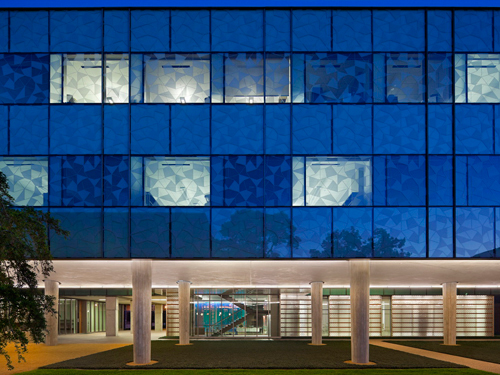
© Peter Aaron/OTTO
The campus of Rice University is a continuously studied and managed “canvas” that represents an intensive ongoing collaboration between architects, planners, and administrators. Its park-like environment—with live oaks, lawns, walkways, arcades, courtyards, and buildings—comprises a clear and timeless vision. The Brockman Hall for Physics needed to fit within this distinctive setting, to gather together a faculty of physicists and engineers working in as many as five separate buildings, and to house highly sophisticated research facilities carefully isolated from the noise, vibrations, and temperature fluctuations that could destroy experiments.
California Memorial Stadium & Simpson Training Center; Berkeley, California
HNTB Architecture; Associate Architect: STUDIOS Architecture
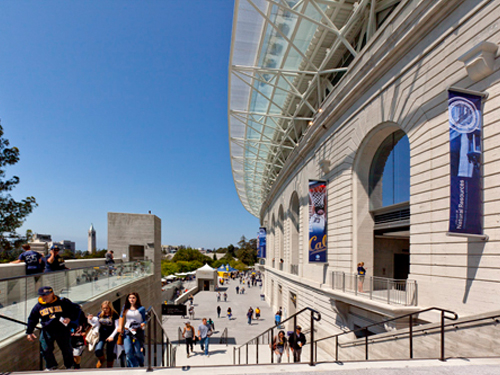
© Michael O’Callahan; Proehl Studios; Tim Griffith; Jim Simmons
The historic stadium is one of the most beloved and iconic structures on the UC Berkeley campus. The key goals for this project were to restore the stadium’s historic and civic prominence, integrate modern training and amenity spaces, and address severe seismic concerns. By setting the new athlete training facility into the landscape, a new grand 2-acre public plaza for the stadium was created on the roof. A new press box/club crowns the historic wall; its truss-like design acts as a counterpoint to the historic facade.
Cambridge Public Library; Cambridge, Massachusetts
William Rawn Associates, Architects, Inc.; Associate Architect: Ann Beha Architects
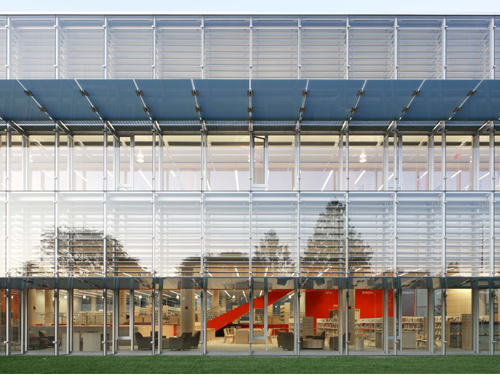
© Chuck Choi; Robert Benson
The Cambridge Public Library has become the civic “Town Common” for a city that celebrates and welcomes its highly diverse community (with over 50 languages spoken in its schools). With its all-glass double-skin curtain wall front facade, the library opens seamlessly out to a major public park. This double-skin curtain wall uses fixed and adjustable technologies to ensure that daylight is infused throughout the interiors and to maximize thermal comfort for the most active patron spaces looking out to the park.
Danish Maritime Museum; Elsinore, Denmark
BIG | Bjarke Ingels Group

© Rasmus Hjortshoj; Luftfoto
The design solution to the site’s inherent dilemmas was to wrap a subterranean museum around a dry dock like a doughnut, where the hole was the dry dock itself and the centerpiece of the museum’s collection. Three two-level bridges span the dry dock, serving as shortcuts to various sections of the museum. All floors slope gently, so that a visitor continually descends further below the water’s edge to learn about Danish maritime lore. The civil engineering and construction work for the museum were among the most complicated ever undertaken in Denmark.
John Jay College of Criminal Justice; New York City
Skidmore, Owings & Merrill LLP
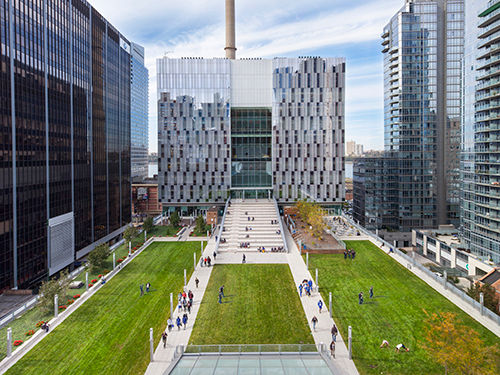
© Eduard Hueber | Archphot; Brett Beye
Located in Manhattan, John Jay College of Criminal Justice’s new building provides all the functions of a traditional college campus within the confines of a single city block. SOM’s 625,000-square-foot addition doubles the size of the college’s existing facilities by adding classrooms, laboratories, auditoriums, faculty offices, and social spaces. These functions are arranged within a new 14-story tower and four-story podium topped with an expansive landscaped terrace that serves as an elevated campus commons. A 500-foot-long cascade runs the length of the podium and functions as the social spine of the campus. SOM’s design places a premium on communal and interactive space so that students may enjoy the experiences of a traditional college setting.
Krishna P. Singh Center for Nanotechnology at the University of Pennsylvania; Philadelphia
WEISS/MANFREDI Architecture/Landscape/Urbanism
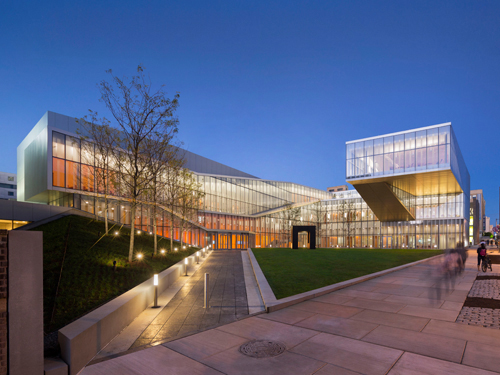
© Albert Vecerka
Challenging the established model of laboratory buildings, the Krishna P. Singh Center for Nanotechnology is organized around an ascending spiral that hybridizes the tradition of the campus quadrangle with the public promenade. The Center for Nanotechnology twists its laboratories around a central campus green, opening the sciences to the University of Pennsylvania’s landscape while providing a suite of public spaces within the building for cross-disciplinary collaboration amongst scientists. Here, multiple types—courtyard, laboratory loft, ascending gallery—each with their own distinct histories, are grafted together to create a new, but recognizable hybrid.
LeFrak Center at Lakeside Prospect Park; Brooklyn, New York
Tod Williams Billie Tsien Architects
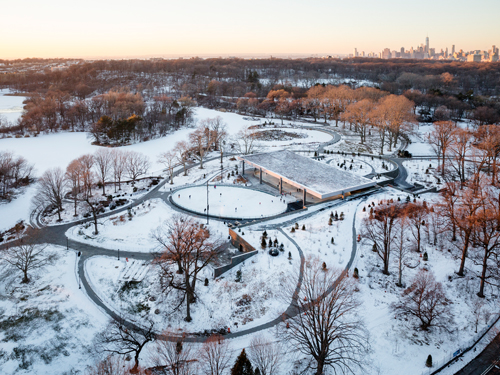
© Michael Moran / OTTO
This project restored 26 acres of Brooklyn’s Prospect Park, designed by Frederick Law Olmsted and Calvert Vaux in the 19th century and added a new 75,000-square-foot, year-round skating and recreational facility. In the winter, the facility’s two rinks are open for ice skating, and in the summer one rink converts to roller skating and the other to a large water-play fountain. Clad in rough-hewn gray granite, the new LeFrak Center appears to be large stone retaining walls set in the landscape. Much of the structure is tucked into the land. The L-shaped plan consists of the east and north block, both one-story structures with roof terraces connected by a bridge.
Sant Lespwa, Center of Hope; Outside of Hinche, Haiti
Rothschild Doyno Collaborative
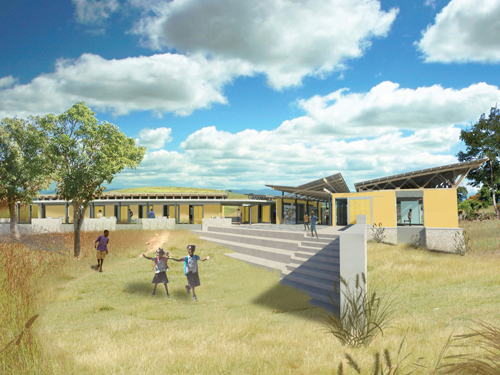
© Rothschild Doyno Collaborative; Sarah Spanagel
The Center of Hope, commissioned by World Vision, is located in a rural region in Haiti and provides support, education, and skill building opportunities. The design process involved the entire community from children to elders. Construction included on-the-job skills training for over 100 residents. The courtyard scheme and breezeway capture prevailing winds while opening expansive views to the mountains beyond. Careful planning for natural ventilation, daylighting, water collection, sewage treatment, and electricity generation resulted in a completely self-sufficient building. The participatory and empathetic process created an uplifting environment that inspires hope.
United States Courthouse, Salt Lake City, Utah
Thomas Phifer and Partners; Naylor Wentworth Lund Architects
The design of the new United States Courthouse in Salt Lake City emanates from a search for a strong, iconic, transparent, and metaphorically egalitarian form to symbolize the American judiciary system. The primary nature of the courthouse’s cubic mass projects grounded dignity, immovable order, and an equal face to all sides. The 400,000-square-foot, 10-story courthouse resides on a landscaped terrace that spans an entire city block, uniting the new and existing federal courthouses as a public-access amenity while fulfilling a required federal security setback from the street.
Wild Turkey Bourbon Visitor Center; Lawrenceburg, Kentucky
De Leon & Primmer Architecture Workshop
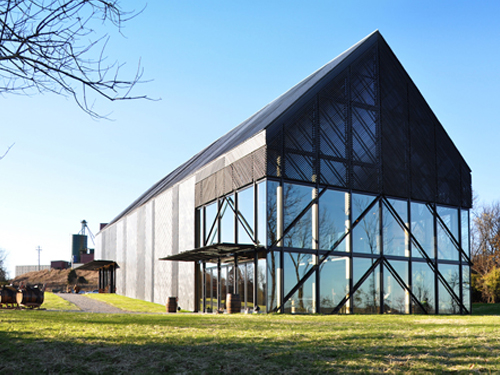
© De Leon & Primmer Architecture Workshop
Located on a bluff overlooking the Kentucky River, the visitor center is the newest component of recent additions and expansions to the Wild Turkey Distillery Complex, one of seven original member distilleries of the Kentucky Bourbon Trail. The 9,140-square-foot facility houses interactive exhibits, a gift shop, event venues, a tasting room, and ancillary support spaces. Utilizing a simple barn silhouette (an interpretation of Kentucky tobacco barns common to the area), the building, clad in a custom chevron pattern of stained wood siding, presents a clear and recognizable marker in the landscape.
Interior Architecture Awards
The 2015AIA Institute Honor Award for Interior Architecture jury includes: Rick Kremer, FAIA (Chair), Architect Rick Kremer, FAIA; Matt Murphy, AIA, RMTA; Luke Ogrydziak, AIA, Ogrydziak Prillinger Architects; Susan Elizabeth Seifert, AIA, seifertmurphy and Steven Shapiro, Hon. AIA, Clark Construction.
Arent Fox; Washington, D.C.
STUDIOS Architecture
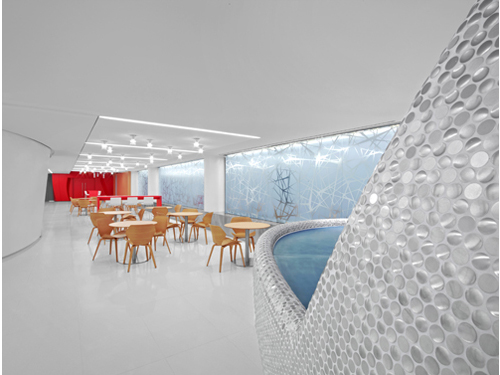
© Eric Laignel
Key elements of this office building include a formal reception space with a physical and visual connection to the building lobby, a conference center, an auditorium with tiered seating, break-out areas for receptions, and slab openings on typical office floors for visual connection to other floors. The building has two primary street-facing sides and two sides that face an alley. To create parity between the two, the design places key elements on the alley side of the building to draw people from the front to the back for collaboration and support functions. Glass was used to shape offices and conference rooms and to blur the line between circulation and enclosed spaces.
The Barbarian Group; New York City
Clive Wilkinson Architects; Design Republic Partners Architects LLP

© Michael Moran
The offices for digital marketing firm The Barbarian Group were designed with connectivity, accessibility, and collaboration in mind. Simplifying the basic needs of the conventional office to their core, an endless table was envisioned that connects all employees at a single surface. The table, dubbed “the Superdesk,” rises and falls throughout the space, lifting over pathways and creating work and meeting grottos beneath its arches. Its plywood underside is made of 870 unique laser-cut panels, and its top surface is a light-reflecting pearlescent white with a clear epoxy coating.
Beats By Dre; Culver City, California
Bestor Architecture
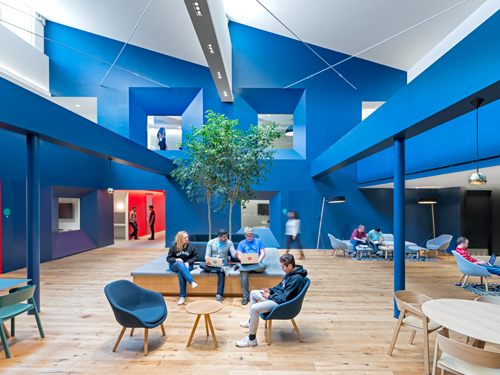
© Jasper Sanidad
The Beats By Dre campus was designed to reflect the diverse and innovative work undertaken in the music and technological fields. The main building is carved by a, two-story lobby that forms an axis and two courtyards to orient the work spaces. Courtyards connect to the varied working environments and include offices, open workstations, flexible work zones, and interactive conference rooms. The office plan encourages interaction and contact across departments by establishing a variety of calculated environments that exist within the larger workspace: peaceful, activated, elegant or minimal.
Crystal Bridges Museum of American Art, Museum Store; Bentonville, Arkansas
Marlon Blackwell Architects
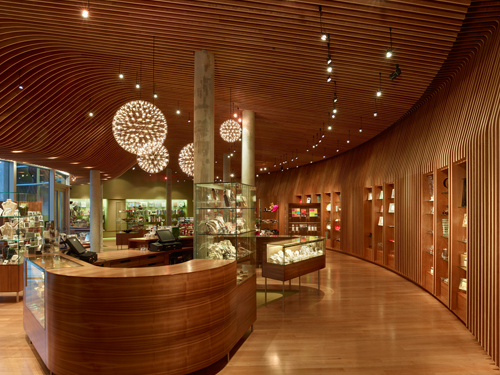
© Marlon Blackwell Architect; Timothy Hursley
The work of a local Arkansas basket maker, Leon Niehues, known for his sculpturally ribbed baskets made from young white oak trees from the Ozarks, provided the design inspiration for the museum store, located at the heart of the Moshe Safdie, FAIA, designed museum (2011) in Bentonville, Arkansas. A series of 224 parallel ribs, made of locally harvested cherry plywood, were digitally fabricated directly from the firm’s Building Information Modeling delivery process. Beginning at the top of the exterior glass wall, the ribs extend across the ceiling and down the long rear wall of the store.
Illinois State Capitol West Wing Restoration; Springfield, Illinois
Vinci Hamp Architects
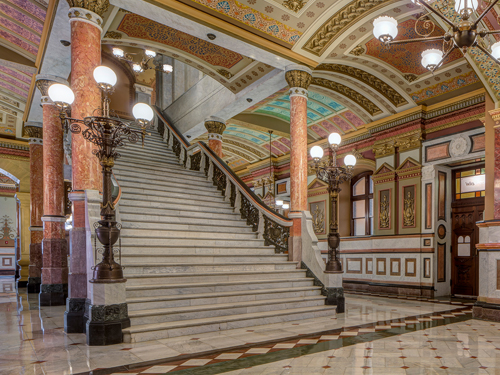
© Tom Rossiter; Bill Zbaren
The West Wing of the Illinois State Capitol is the second phase of a comprehensive renovation program of this 293,000-square-foot National Historic Landmark. Designed by French émigré architect Alfred Piquenard between 1868 and 1888, the Capitol represents the apogee of Second Empire design in Illinois. Over the years inappropriate changes were made through insensitive modifications and fires. The project mandate was to restore the exuberant architecture of the West Wing’s four floors and basement, while simultaneously making necessary life safety, accessibility, security and energy efficient mechanical, electrical, & plumbing system upgrades.
Louisiana State Museum; Natchitoches, Louisiana
Trahan Architects
The Louisiana State Museum merges historical and sports collections, elevating the experience for both. Set in the oldest settlement in the Louisiana Purchase on the banks of the Cane River Lake, the quiet yet innovative design reinterprets the geometry of the nearby plantation houses and the topography of the riverfront; between past and future. Spaces flow together to accommodate exhibits, education, event and support functions. The hand-folded copper container contrasts with the digitally carved cast-stone entry and foyer within, highlighting the dialogue between the manmade and the natural.
National September 11 Memorial Museum; New York City
Davis Brody Bond
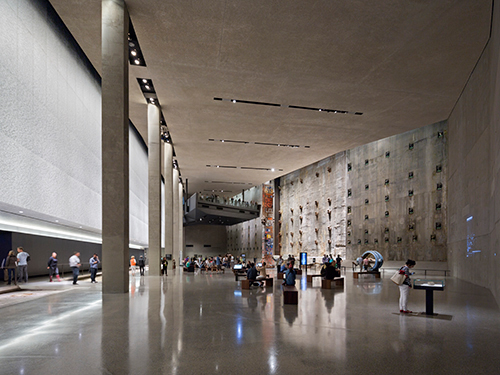
© James Ewing; Andrew Moore; Davis Brody Bond
The 9/11 Memorial Museum is built upon the foundations of the Twin Towers, 70 feet below street level. Visitors reach the museum via a gently sloped descent, a journey providing time and space for reflection and remembrance. Iconic features of the site, such as the surviving Slurry Wall, are progressively revealed. This quiet procession allows visitors to connect to their own memories of 9/11 as part of the experience. Located at the site of the event, the museum provides an opportunity to link the act of memorialization with the stories, artifacts and history of that day.
Newport Beach Civic Center and Park; Newport Beach, California
Bohlin Cywinski Jackson
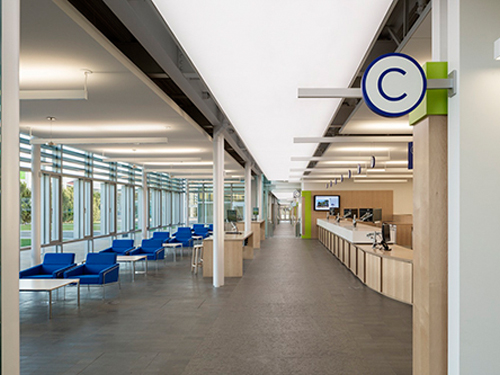
© Tim Griffith; Nic Lehoux
The Newport Beach Civic Center and Park creates a center for civic life in this Southern California beachside community. Nestled within a new 17-acre park, the City Hall is designed for clarity and openness. A long, thin building supporting a rhythmic, wave-shaped roof provides a light and airy interior, complemented by connections to outdoor program elements, a maritime palette, and commanding views of the Pacific Ocean. The project’s form and expression are generated by place and sustainability, as well as the City’s democratic values of transparency and collaboration.
Regional and Urban Design Awards
The jury for the 2015 Institute Honor Awards for Regional & Urban Design includes: Frank Fuller, FAIA, (Chair), Field Paoli; Karl Grice, AIA, Grice Group; Anne-Marie Lubenau, AIA, Bruner Foundation; Klaus Philipsen, FAIA, ArchPlan and Adam Thies, AICP, Director of the Indianapolis Department of Metropolitan Development.
Beijing Tianqiao (Sky Bridge) Performing Arts District Master Plan; Beijing, China
Skidmore, Owings & Merrill LLP
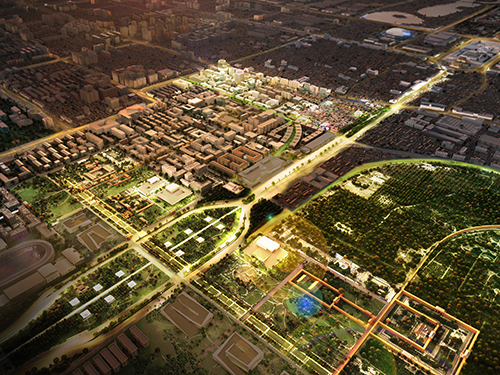
© Skidmore, Owings & Merrill LLP; Christopher Grubbs; Squint/Opera
Old Tianqiao was once a bustling hub of cultural activities and folk arts traditions ranging from storytelling, variety shows, acrobatics, and operas. The project intends to reestablish the cultural heart of the capital with a collection of modern and traditional performance venues that respect the city’s sensitive, World Heritage context. An integrated design process across many disciplines laid out a series of environmental goals, including reintroducing the historic farm fabric, developing a storm water filtration system, reducing waste by using existing materials, and reducing automobile dependence and carbon footprint by creating walkable neighborhoods around three new subway stations.
The BIG U; New York City
BIG | Bjarke Ingels Group
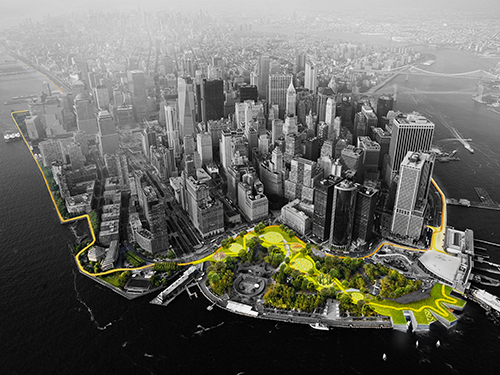
© Daniel Acker/Bloomberg; BIG Team
The BIG U is a 10-mile protective ribbon around lower Manhattan that addresses vulnerabilities exposed by Superstorm Sandy (2012). The BIG U consists of three components: BIG Bench, Battery Berm, and Bridging Berm. BIG Bench is a continuous protective element adapted to the local context that mediates new and existing infrastructure. The Battery Berm weaves an elevated path through the park, enhancing the public realm while protecting the Financial District and critical transportation infrastructure. This signature building features a “reverse aquarium” that enables visitors to observe tidal variations and sea level rise. The Bridging Berm rises 14 feet by the highways, connecting the coast and communities with greenways.
Government Center Garage Redevelopment; Boston
CBT Architects
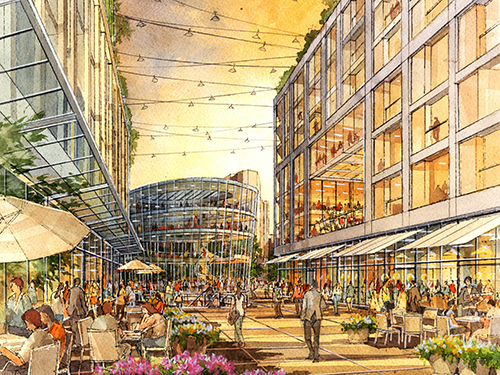
© Lifang; CBT
The redevelopment of the Government Center Garage project is an example of undoing the ills of the 1960's urban renewal in Boston that critically separated six thriving neighborhoods. The plan unlocks neighborhood connections, reopens urban vistas, and creates engaging public spaces by strategically removing a portion of the garage while preserving the remaining structure through creative phasing to provide for a sustainable and economically feasible redevelopment. The project introduces 3 million square-feet of housing dominant mixed-use program to downtown, creating a dynamic 24-hour neighborhood as a model for sustainable, transit-oriented development. The project also sets up a new position for urban design in Boston by shaping the urban form to respond to acute desire lines of a pre-grid city and promoting slender building typologies.
Target Field Station; Minneapolis
Perkins Eastman
Target Field Station, opened in May 2014, is a distinctive transit station located in the heart of Minneapolis' revitalized North Loop neighborhood. The project links the street fabric of the existing neighborhood with Target Field Stadium Promenade and to the larger downtown core beyond. The station seamlessly links parking, light rail, regional rail, bus and bicycle modes of transit – while always privileging ease of pedestrian access. It also provides of a series of interconnected public open spaces, including an amphitheater and a ‘Great Lawn’ as additional amenities for public use. By combining sustainable design, carefully crafted public space, landscape elements, public art, and private development, Target Field Station sets the bar for how modern cities leverage transit design to create iconic cultural centers.
Read the full report at: http://www.aia.org/press/releases/AIAB105268
Related Stories
Senior Living Design | Apr 24, 2024
Nation's largest Passive House senior living facility completed in Portland, Ore.
Construction of Parkview, a high-rise expansion of a Continuing Care Retirement Community (CCRC) in Portland, Ore., completed recently. The senior living facility is touted as the largest Passive House structure on the West Coast, and the largest Passive House senior living building in the country.
Hotel Facilities | Apr 24, 2024
The U.S. hotel construction market sees record highs in the first quarter of 2024
As seen in the Q1 2024 U.S. Hotel Construction Pipeline Trend Report from Lodging Econometrics (LE), at the end of the first quarter, there are 6,065 projects with 702,990 rooms in the pipeline. This new all-time high represents a 9% year-over-year (YOY) increase in projects and a 7% YOY increase in rooms compared to last year.
Architects | Apr 24, 2024
Shepley Bulfinch appoints new Board of Director: Evelyn Lee, FAIA
Shepley Bulfinch, a national architecture firm announced the appointment of new Board of Director member Evelyn Lee, FAIA as an outside director. With this new appointment, Lucia Quinn has stepped down from the firm’s Board, after serving many years as an outside board advisor and then as an outside director.
ProConnect Events | Apr 23, 2024
5 more ProConnect events scheduled for 2024, including all-new 'AEC Giants'
SGC Horizon present 7 ProConnect events in 2024.
75 Top Building Products | Apr 22, 2024
Enter today! BD+C's 75 Top Building Products for 2024
BD+C editors are now accepting submissions for the annual 75 Top Building Products awards. The winners will be featured in the November/December 2024 issue of Building Design+Construction.
Laboratories | Apr 22, 2024
Why lab designers should aim to ‘speak the language’ of scientists
Learning more about the scientific work being done in the lab gives designers of those spaces an edge, according to Adrian Walters, AIA, LEED AP BD+C, Principal and Director of SMMA's Science & Technology team.
Resiliency | Apr 22, 2024
Controversy erupts in Florida over how homes are being rebuilt after Hurricane Ian
The Federal Emergency Management Agency recently sent a letter to officials in Lee County, Florida alleging that hundreds of homes were rebuilt in violation of the agency’s rules following Hurricane Ian. The letter provoked a sharp backlash as homeowners struggle to rebuild following the devastating 2022 storm that destroyed a large swath of the county.
Mass Timber | Apr 22, 2024
British Columbia changing building code to allow mass timber structures of up to 18 stories
The Canadian Province of British Columbia is updating its building code to expand the use of mass timber in building construction. The code will allow for encapsulated mass-timber construction (EMTC) buildings as tall as 18 stories for residential and office buildings, an increase from the previous 12-story limit.
Standards | Apr 22, 2024
Design guide offers details on rain loads and ponding on roofs
The American Institute of Steel Construction and the Steel Joist Institute recently released a comprehensive roof design guide addressing rain loads and ponding. Design Guide 40, Rain Loads and Ponding provides guidance for designing roof systems to avoid or resist water accumulation and any resulting instability.
Building Materials | Apr 22, 2024
Tacoma, Wash., investigating policy to reuse and recycle building materials
Tacoma, Wash., recently initiated a study to find ways to increase building material reuse through deconstruction and salvage. The city council unanimously voted to direct the city manager to investigate deconstruction options and estimate costs.


